By Joshua Cline
A man emblematic of the Maryland National Guard is Joseph Farinholt. Born in Catonsville on 17 July 1922, he joined the Maryland National Guard in 1939 at the age of 16, becoming a member of Company B, Maryland Fifth Regiment. When the Fifth Regiment was federalized as the 175th Infantry Regiment in 1940, it was attached to the 29th Infantry Division. On 6 June 1944, Corporal Farinholt landed on Omaha Beach as part of an anti-tank platoon. He earned his first of four Silver Stars during the advance on St. Lo on 13 July for killing a mortar team and destroying a German tank; his second on 18 July when his battalion was being overrun for saving three anti-tank guns from the maelstrom; his third on 13 October for leading teams rescuing wounded men during an attack by a company-size German formation; and his fourth on 26 November in Bourheim, Germany, manning an anti-tank gun by himself to stymie a German armor attack, nearly at the cost of his life. His fourth Silver Star was considered for upgrade to the Medal of Honor in 2001, but it was ultimately declined to upgrade it for lack of living eyewitnesses. Technical Sergeant Farinholt is believed to be the only enlisted man in U.S. military history to have been awarded the Silver Star four times. He spent most of his life walking the halls of the building the Maryland Museum of Military History resides in.
The Fifth Regiment Armory was built in 1901 by the architectural partnership Wyatt & Nolting, responsible for several Maryland and Northern Virginia landmarks. Located on what is now 29th Division Street, the Armory was finished in 1903 just in time for the Great Baltimore Fire of 1904, with the fire breaking close to the building. It functioned as a center for displaced businesses while Baltimore recovered. The 1912 Democratic National Convention was held within its walls, to nominate Woodrow Wilson for the presidency. After a fire in 1933, the state rebuilt the structure. The Armory consists of a full basement, a main floor with a 200 by 300-foot drill hall, a mezzanine, three full and a partial fourth floor. Built to outwardly resemble a medieval fortification, the large and imposing building is a military post through and through.
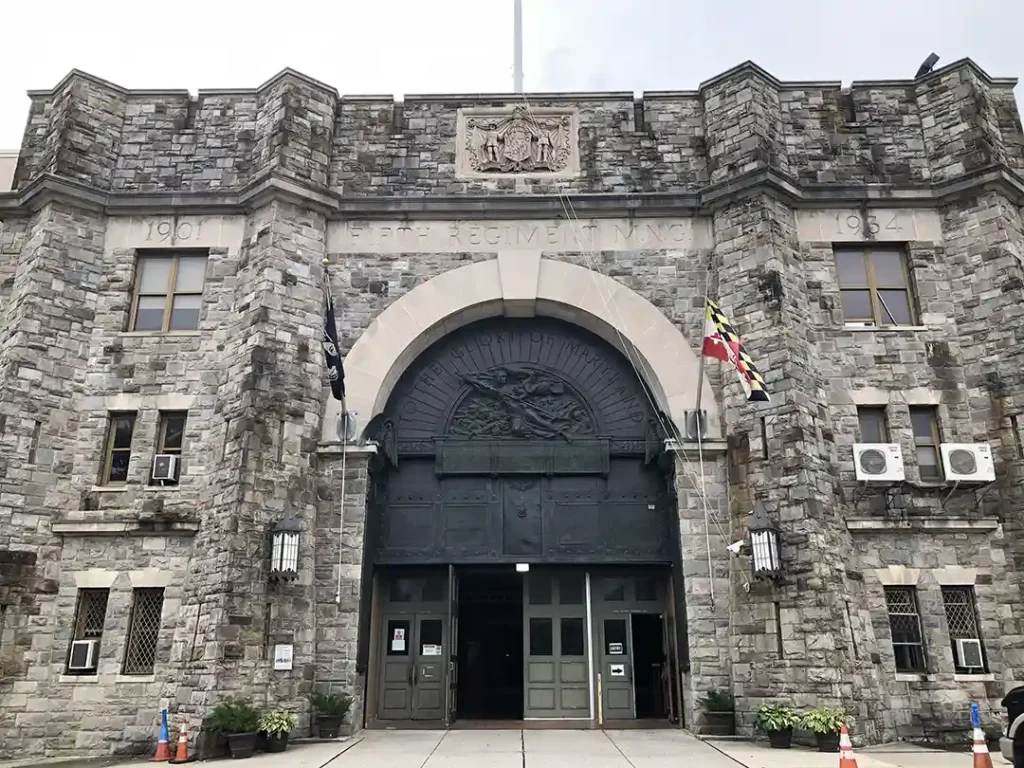
In 1985, the building was added to the National Register of Historic Places. Until 1995, it was the headquarters of 1st Battalion, 175th Infantry Regiment, the unit that claims the lineage of the Fifth Maryland (it is one of only nineteen National Guard units with a War of 1812 campaign credit and goes back to Mordecai Gist’s Baltimore Independent Cadets). Since then, it has served as the headquarters of the Maryland National Guard. It is the largest armory still in active use by the National Guard (the Kingsbridge Armory in the Bronx, New York, is the largest, but not in active use). A banner over the inner entrance proudly proclaims, “Welcome to the Maryland National Guard.”
The unit for which the Fifth Regiment Armory was built is, aside their wartime feats, most famous for the Baltimore Railroad Riot of 1877. During this riot, police and Maryland militia regiments clashed with rioters throughout the city. The Fifth and Sixth Regiments were mustered on 20 July. The Fifth marched toward Camden Station for a train to Cumberland, whose mayor had requested troops to protect public property. They were initially applauded by onlookers when they set out from the Richmond Market Armory. Located in a rich area of the city, the Fifth was only occasionally confronted. On Eutaw street, a violent crowd severely injured several militiamen, but the Fifth were restrained in their response to the civil unrest, forcing their way through without bloodshed. Blocked from Camden Station by a large crowd currently in the process of burning and looting the area, Captain William P. Zollinger had the Fifth fix bayonets and double time to access the station, pushing people aside and securing the station with a minimum of violence.
The same could not be said for the Sixth Regiment that moved after them. Located in a working-class area much more affected by the circumstances that fermented the riot, and being the largest of the Maryland militia regiments, there was very little order to the unit in comparison to the Fifth. They were besieged in their armory before the march. When three companies sallied forth for Camden Station, they were assaulted by stones thrown by a growing crowd. The Sixth opened fire several times during the march with lethal results, killing at least thirteen. Multiple members of the Sixth broke ranks and deserted during the march. With both regiments now in Camden Station, the mob numbering perhaps 15,000 tried and failed to take it over twice during the night. During the night, most of the Sixth’s men deserted, with the remainder incorporated into the Fifth. Incorporated as well were the newly created Seventh and Eighth Regiments. With the riot largely having ended within a day, the Fifth held in Camden Station until relieved by federal forces. Open violence ended on Monday, 23 July. Despite all that had happened, no result came from the riot, only destruction. With the unit disgraced by their conduct during the strike, the Sixth Regiment was disbanded. In comparison, the Fifth Regiment was lauded for their restraint, their actions praised by officials and citizens alike, with many new volunteers.
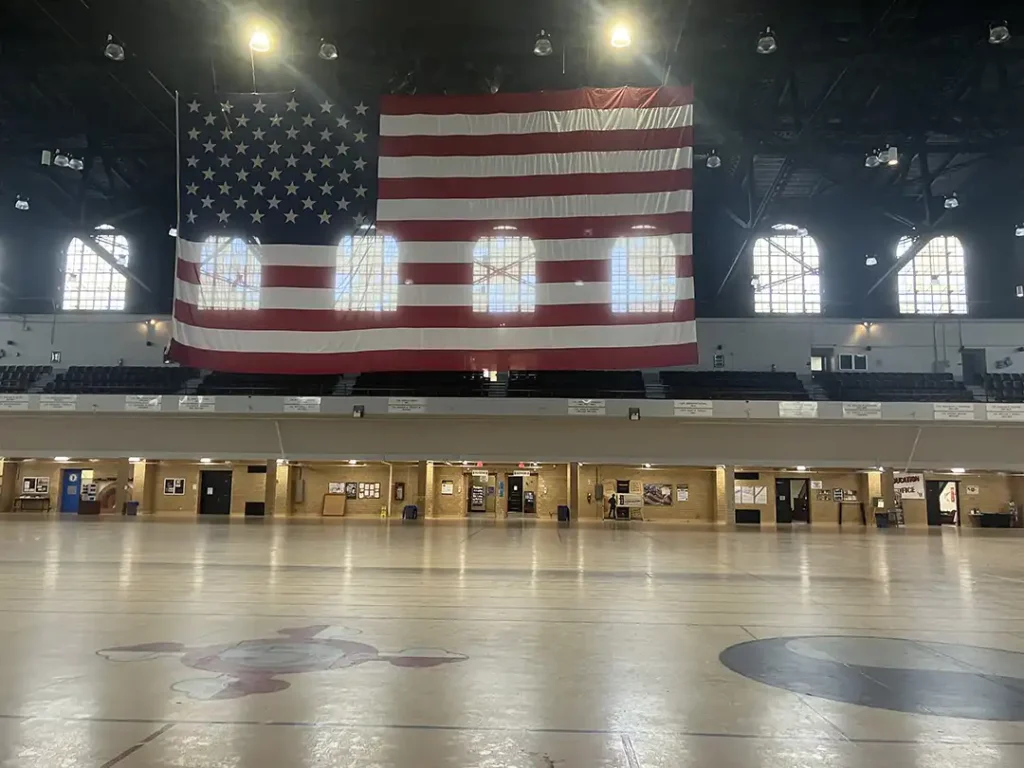
The Maryland Museum of Military History was founded in 1982 to preserve the history and heritage of Maryland’s National Guard, as well as the militias that preceded it. It also serves to tell the stories of all Marylanders who served, regardless of branch of service. The museum is housed within the Fifth Regiment Armory. While the fortification was not intended for use as a museum and historical archive, the handful of museum employees and volunteers within its walls have created admirable achievements. Of particular significance is the Witte Memorial Archives for the 29th Infantry Division, with secure storage onsite, and plans to expand it during 2025. Due to the architecture of the Armory, there is not a continuous path through the museum, which is housed in several rooms throughout the back walls. The museum is split between several sections, not all of which are an unbroken timeline.
The John Eager Howard room displays the beginnings of Maryland militias through the Revolutionary War, starting with two militia captains in 1634. Particular attention is called to Marylanders in the Revolutionary War, highlighting heroes like the Maryland 400 in the Battle of Long Island that earned Maryland the nickname of the “Old Line State.” Particular attention is paid to Brigadier General Mordecai Gist, who survived the battle and was present at the surrender of Lord Cornwallis at Yorktown. Gist formed the Baltimore Independent Cadets, one of the state’s first militia units. The room depicts the evolution of the Guard from scattered companies to consolidation into regiments, particularly with the Militia Act of 1792. Another Maryland 400 veteran was Senator Samuel Smith, a major general of the militia during the War of 1812, who commanded the defenses of Baltimore and protected the city from the British in September 1814.
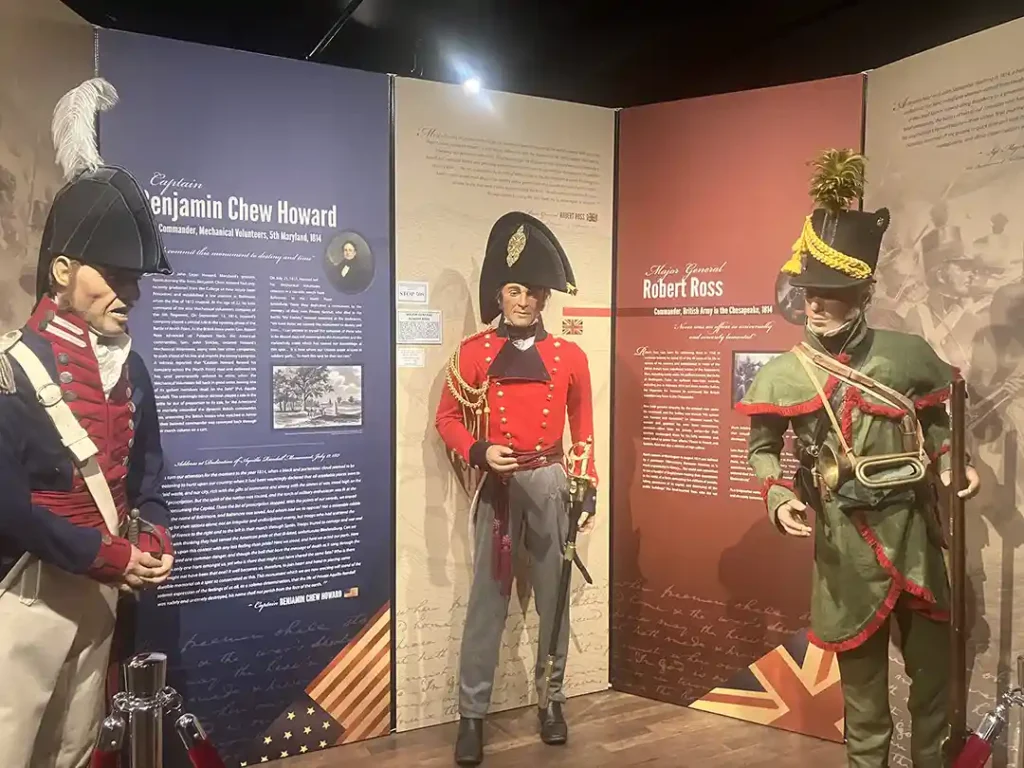
The When Freeman Shall Stand exhibit features the War of 1812. Of particular focus is the bombardment of Fort McHenry (best known for the inspiration for “The Star Spangled Banner”) and the Battle of Baltimore. Several soldiers are featured here, including Captain Benjamin Chew Howard, whose Mechanical Volunteers of the Fifth Regiment were pivotal in the opening phase of the Battle of North Point, 12 September 1814, and Major General Robert Ross, who commanded the British Army in the Chesapeake in 1814, captured Washington, and was later killed by a militia sharpshooter at North Point.
Kenly Hall is the room dedicated to the Civil War, depicting both Union and Confederate units, with greater emphasis on the Union. Medal of Honor recipient Sergeant Major Christian Fleetwood of the 4th Regiment Infantry, Maryland Volunteers, who enlisted after the Emancipation Proclamation, is featured with a mannequin. So is Medal of Honor recipient Colonel John R. Kenly of the 1st Regiment Infantry, Maryland Volunteers, who commanded the Maryland Brigade in the Army of the Potomac until July 1863, when he was breveted a major general. He was the highest ranked Marylander in the Union Army and the hall is named in his honor. The Maryland National Guard’s motto—“Rally ‘Round the Flag!”—is said to have originated with him at the Battle of Front Royal in 1862. During that battle, his 1st Regiment Maryland Volunteer Infantry were forced to fight their brothers in the 1st Maryland Infantry Regiment (Confederate). During the Civil War, Maryland was the northernmost Southern state, which meant the population split almost equally in support of both sides. The museum depicts the division of support within the state during the Civil War in a respectful way, with real and genuine care.
The Gilded Age Room covers the years 1867 to 1917. It depicts events like the 1877 Baltimore Railroad Strike; the Militia Act of 1903 that officially established the National Guard; the 1904 Great Baltimore Fire; Maryland militia service during the Spanish-American War; and service on the border with Mexico in 1916-17. Included in this room is a Gatling gun taken off the USS Constellation; a mannequin and display for Medal of Honor recipient Private Augustus Walley of Troop I, 9th Cavalry, awarded for service in the Indian Wars in 1881; and the Medal of Honor of Private First Class Henry G. Costin, Company H, 115th Infantry Regiment, who was killed in action during World War I.
Costin Hall, named for Medal of Honor recipient Henry Costin, features the birth of the 29th Division and houses the Over There! exhibit for World War I. It depicts the story of the Maryland National Guard in Europe, starting with the 117th Trench Mortar Battery of the 42d “Rainbow” Division, a unit that became known as the “First to Fight” in the state. It then continues to the 29th Division’s founding and combat service on the Western Front. Featured as well is the Monumental City Guards founded in 1879, the Maryland National Guard’s first African American unit. Alongside units from the District of Columbia, Ohio, Massachusetts and Connecticut, the Monumental City Guards formed the 372d Infantry Regiment. They fought with the French 157th “Red Hand” Division. Today the Maryland National Guard’s 729th Quartermaster Company is the descendant unit of the Monumental City Guards. The room also features Johns Hopkins Base Hospital No. 18, affiliated with Baltimore’s Johns Hopkins Hospital. The exhibit focuses on Chief Nurse Bessie Baker, who led sixty-five nurses to France. Also included is the key part of Maryland in the Army’s early aviation, being where College Park Airfield is located, and having multiple important aviators during World War I, like ace pilot Francis Gillet. Last but certainly not least, a featured soldier of the exhibit is Sergeant Henry Gunther, a Baltimore native who was the final American casualty of the war and the last casualty of either side on the Western Front.
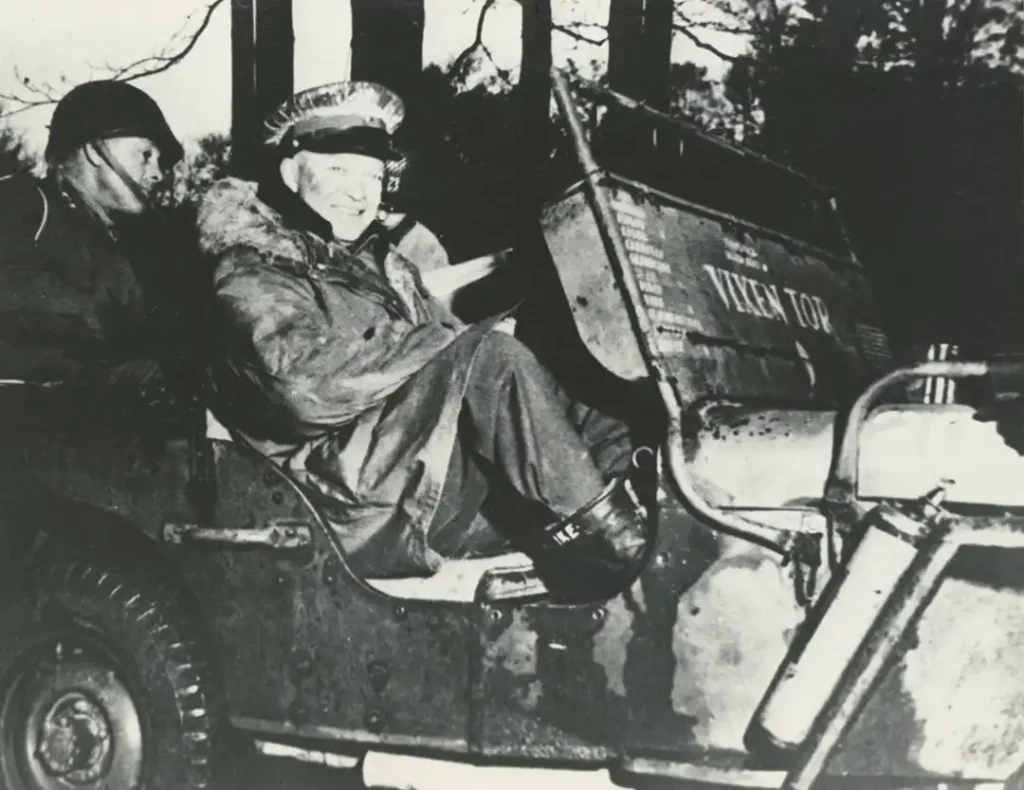
Farinholt Hall, separated from the World War I room by the drill hall, follows the 29th Infantry Division from Fort Meade, Maryland to the River Elbe in Germany during World War II. It is named after Technical Sergeant Joseph Farinholt, mentioned earlier. As of this writing, the room is a work-in-progress and not ready for public viewing. It will soon have a large mural from the former Fort George G. Meade Museum, one of many post museums closed in the 2000s. In the meantime, the centerpiece of the exhibit is the jeep Vixen Tor. It was the vehicle of Major General Charles H. Gerhardt, who commanded the 29th Infantry Division on D-Day. Photographs of the vehicle in use include General Dwight D. Eisenhower sitting in it. There is a German helmet welded to the grille of the jeep; the story of this unusual ornamentation is that of a battlefield trophy. General Eisenhower ordered it removed from the vehicle, but it was kept and later sent through the mail by the driver of the jeep. Once the vehicle found a home at the Fifth Regiment Armory, the helmet was welded back onto the grille. Of note are the original colors of the 115th Infantry Regiment (descendant unit of the First Maryland), which flew in France.
The Cold War Room begins with the Maryland National Guard’s integration after President Harry S. Truman signed Executive Order 9981 in 1948. It also portrays the rise of the Maryland Air National Guard. Particular note is given to the 31st Truck Battalion in the Korean War; the Baltimore Riots of 1968; civil rights displays for the Vietnam War; the 1,027 Marylanders who were killed in action during the Vietnam War; and the military policemen sent to the Gulf War in 1991. It is connected to the room depicting the War of 1812.
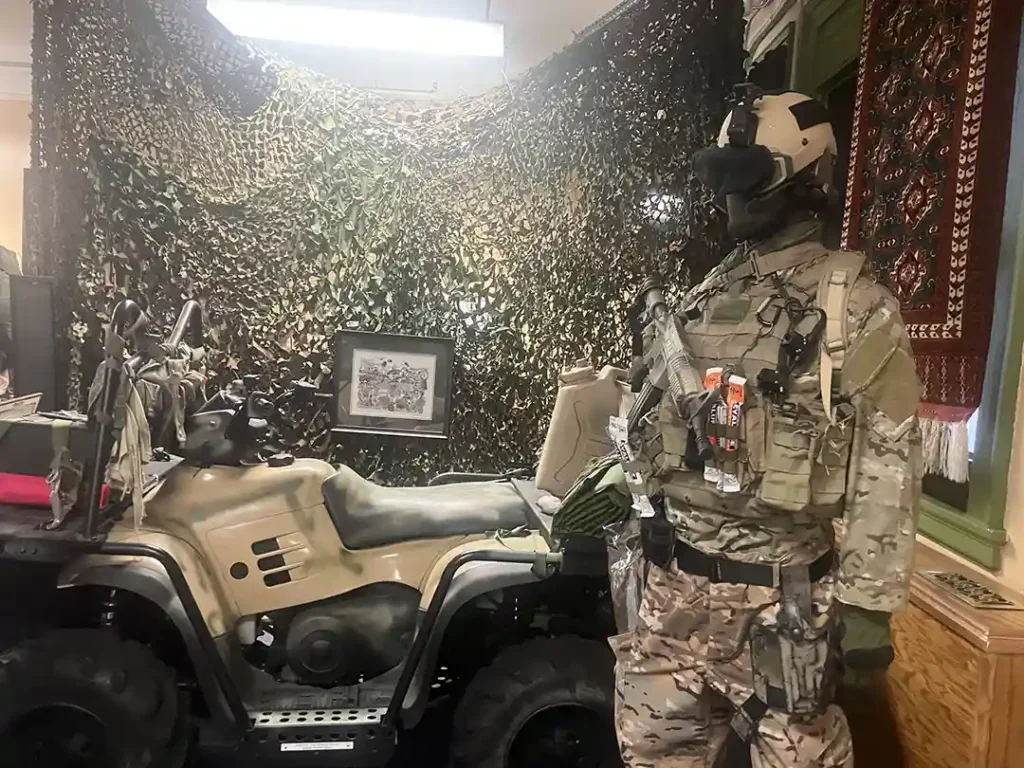
The room for the Modern Wars and Domestic Support exhibit is also connected to the War of 1812 room. This exhibit area focuses on the Maryland National Guard in global conflicts from 1991 to the modern day, women in the Guard, and domestic crises. The Maryland National Guard was called up in response to 9/11, providing military police to secure the Pentagon after Flight 77 hit the building. The Maryland National Guard was involved in Iraq from the beginning of the 2003 invasion and years afterwards. Highlights include a recreated office space for a forward operating base; captured weaponry, including an RPG-7; rubble of the Pentagon; the Maryland National Guard’s work in Bosnia, Guantanamo, and the Sinai; and more. Of note is the display of a quadbike and mannequin of Special Forces equipment. It represents the first Maryland National Guard unit to engage a foreign combatant since World War II—Company B, 2d Battalion, 20th Special Forces Group, called to federal service on 27 January 2003 and deployed to Afghanistan during Operation ENDURING FREEDOM.
Among other intriguing displays in the Modern War room are the photographs of the December 2018 command staff; one of which, Major General Janeen L. Birckhead, is currently the Adjutant General of the Maryland National Guard. At the time, the Adjutant General was Major General Lina L. Singh. The rest are Brig. Gen. April Vogel (assistant adjutant general for Air), Brig. Gen. Janeen L. Birckhead (assistant adjutant general for Army), and Command Sgt. Maj. Perlisa D. Wilson (senior enlisted adviser for Maryland’s National Guard). A map also depicts the Maryland National Guard in Operation CAPITOL RESPONSE, for the Maryland Guard was the first to respond on 6 January 2021 to the violence at the U.S. Capitol in Washington, DC. Units that responded protected the Presidential Inauguration on 20 January and remained in Washington until 30 January, at which point they returned to Maryland and immediately pivoted to supporting the fight against COVID-19 in Operation STEADFAST GUARDIAN.
For tour groups and honor flights, the Reckord Lounge is accessible. It is named after Lieutenant General Milton A. Reckord, who commanded the 29th Division from 1934 to 1942, and was Provost Marshal in the European Theater from 1944 to 1945. This room features the portraits of 175th Infantry Regiment commanders, former Maryland TAGs since 1920, and plenty of memorabilia and comfortable seats. It is often used for events like promotions and re-enlistment ceremonies.
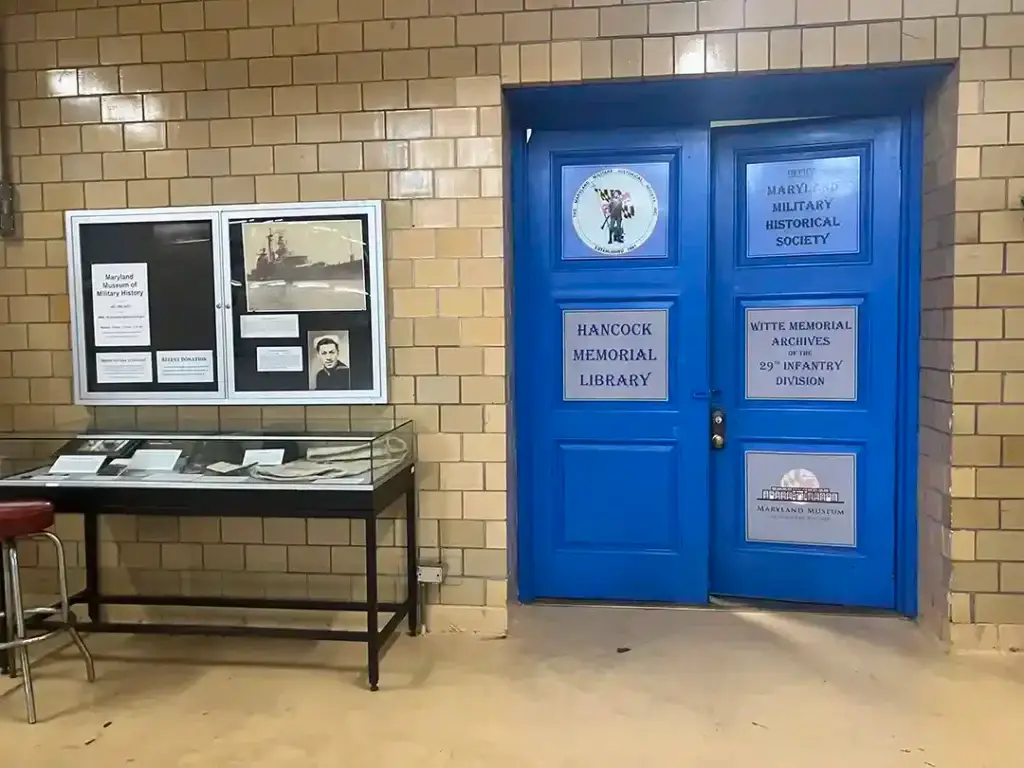
Last but very certainly not least is the Historical Research Center, consisting of the Witte Memorial Archives of the 29th Division and the Hancock Memorial Library. With excellent secure storage for the world-class archive, memorable artifacts on display and a small but dedicated team, the Maryland Museum of Military History should be the first stop for anybody researching the 29th Infantry Division or Maryland National Guard.
Making A Visit
The Maryland Museum of Military History is located in Baltimore on 29th Division Street, within the Fifth Regiment Armory. Admission is free; parking is available inside the fenced area. You must show a picture ID to enter. Currently the Fifth Regiment Armory and the museum are under repair and renovations, but remain open to the public, with only the rooms under renovation closed. The staff request you please call ahead to confirm the museum’s ability to receive visitors before any potential visit. The museum’s hours are 0900-1600, Tuesday through Friday. Visitation on Saturday through Monday is by appointment only. Using the Center’s archives also requires an appointment ahead of time. Guided tours are available but must be scheduled a minimum of three days in advance of the desired date.
For more information, call (667) 297-3470 or visit https://military.maryland.gov/NG/Pages/MMMH.aspx.



